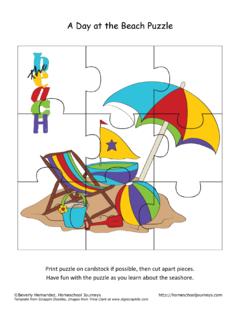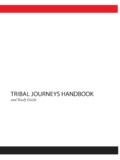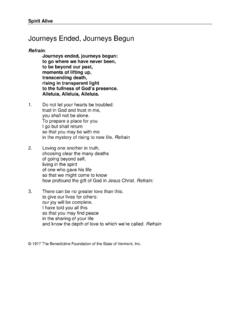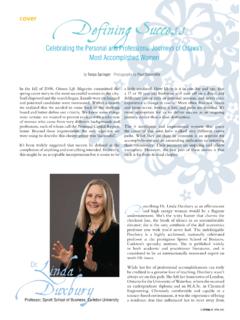Transcription of Journey around Australia LIt Unit - ASLA
1 _____1 Australian School Library Association Inc. This work is licensed under the Creative Commons AttributionNonCommercial-ShareAlike Unported License. To view a copy of this license, visit or send a letter to Creative Commons, 444 Castro Street, Suite 900, Mountain View, California, 94041, USA. Journeys around Australia Literature Unit Based on the picture book Are we there yet? by Alison Lester NB Further ideas can be found in Hunter, L 2004, Are we there yet? , The Literature Base, , Issue 4, pp. 4-7 Years 1 to 4 (adaptable for different year levels) Curriculum Areas: Geography, English, Curriculum content drawn from the ACARA Australian Curriculum website ) Geography: Foundation Year 2 (Drawn from draft Geography Curriculum; January 2011) Environmental Characteristics Environments and living creatures local places, their main characteristics and changes Human Characteristics Places characteristics and change Local environments, life forms and caring for the environment Geography: Years 3-4 (Drawn from draft Geography Curriculum.
2 January 2011) Population and culture rural and urban Differences between places and why differences exist, for example, urban and rural places Connections of places with other places, including culture Landforms and environmental change Land formations, for example, mountains, plains, valleys or coasts (link with science) Location and spatial patterns of particular environments and features Location and main characteristics of the states, territories and major cities of Australia . _____2 Australian School Library Association Inc. This work is licensed under the Creative Commons AttributionNonCommercial-ShareAlike Unported License. To view a copy of this license, visit or send a letter to Creative Commons, 444 Castro Street, Suite 900, Mountain View, California, 94041, USA. English - Year 1 Language Explore differences in words that represent people, places and things (nouns and pronouns), actions (verbs), qualities (adjectives) and details like when, where and how (adverbs)
3 Compare different kinds of images in narrative and informative texts and discuss how they contribute to meaning Literature Discuss features of plot, character and setting in different types of literature and explore some features of characters in different texts Listen to, recite and perform poems, chants, rhymes and songs, imitating and inventing sound patterns including alliteration and rhyme English - Year 2 Language Identify language that can be used for appreciating texts and the qualities of people and things Recognise that capital letters signal proper nouns Literature Discuss the characters and settings of different texts and explore how language is used to present these features in different ways Identify, reproduce and experiment with rhythmic, sound and word patterns in poems, chants, rhymes and songs Discuss the characters and settings of different texts and explore how language is used to present these features in different ways Discuss how language is used to describe the settings in texts and explore how the settings shape the events and influence the mood of the narrative English - Year 3 Language Understand that successful cooperation with others depends on shared use of social conventions, including turn-taking patterns, and forms of address that vary according to the degree of formality in social situations Identify the effect on audiences of techniques, for example shot size, vertical camera angle and layout in picture books, advertisements and film segments _____3 Australian School Library Association Inc.
4 This work is licensed under the Creative Commons AttributionNonCommercial-ShareAlike Unported License. To view a copy of this license, visit or send a letter to Creative Commons, 444 Castro Street, Suite 900, Mountain View, California, 94041, USA. Literature Draw connections between personal experiences and the worlds of texts, and share responses with others Discuss how language is used to describe the settings in texts and explore how the settings shape the events and influence the mood of the narrative English Grade 4 Language Understand how texts vary in complexity and technicality depending on the approach to the topic, the purpose and the intended audience Identify features of online texts that enhance readability including texts navigation, links, graphics and layout Incorporate new vocabulary from a range of sources into students own texts including vocabulary encountered in research Literature Discuss how authors and illustrators make stories exciting, moving and absorbing and hold readers interest by using various techniques.
5 For example character development and plot tension Discuss how authors and illustrators make stories exciting, moving and absorbing and hold readers interest by using various techniques, for example character development and plot tension General Capabilities Literacy Capabilities Comprehending texts through listening, reading and viewing Visual knowledge Critical and Creative Thinking Capabilities Inquiring identifying, exploring and clarifying information o Define and plan information searches o Locate and access data and information o Select and evaluate data and information Creating with ICT (extension activity) o Generate products or solutions for challenges and learning area tasks. _____4 Australian School Library Association Inc. This work is licensed under the Creative Commons AttributionNonCommercial-ShareAlike Unported License.
6 To view a copy of this license, visit or send a letter to Creative Commons, 444 Castro Street, Suite 900, Mountain View, California, 94041, USA. Unit: Journeys around Australia Aim: to help the students understand where some places in Australia are that are mentioned in many of the picture books they are familiar with as well as Are we there yet? Introduction: Read Are we there yet? By Alison Lester (Penguin, 2004) Teaching points: 1. Have a large wall map of Australia placed on a display board near where the class is working. Place on the wall map the town or city you are in. Ask the students if they know of any other towns or cities nearby to place on the map. Use sticky notes. 2. As you read Alison Lester s book, write down a list of the places she mentions (she mentions about 6 or 7 from each state - so the class could do a few pages at a time, depending on the age of the class) At the end of the story look again at the paces mentioned in the text.
7 Ask the class if they know where any of these places are. Place a sticker on the map showing where these places are. Talk about how far each place is from the next, how big it is and what there is to see there. 3. Read the story again, pointing out where the story goes on the map. 4. Give the students a blank outline of the map of Australia and ask them to put the places on the map (group of individual) Class work: 1. Have the names of all the places in Alison s book written on a sheet. Photocopy the sheet so that each group of students has a collection of all the names of the places. After cutting each name from the sheet, place them in the same order they appear in the story and place them on their blank map. Students can use their map and names to recount the story to their group. Students may like to make up a similar story using different places they know of around Australia .
8 _____5 Australian School Library Association Inc. This work is licensed under the Creative Commons AttributionNonCommercial-ShareAlike Unported License. To view a copy of this license, visit or send a letter to Creative Commons, 444 Castro Street, Suite 900, Mountain View, California, 94041, USA. 2. Select an appropriate song for each state for the class to sing ( Kookaburra sits in the old gum tree for Victoria, On the road to Gundagai for NSW, The song of Australia for SA, I ve been everywhere for NT, Waltzing Matilda for Queensland, etc) Have the class sing the songs when talking about each of the states the family visits in Are we there yet? What sort of songs do you think this family may have sung on their Journey ? 3. Look closely at one of the double page spreads. Look at the various types of pictures, maps and art work that are displayed on that page.
9 How does this make each page more interesting? Look at several other picture books to compare them with this one. How do the other picture books attract their readers? How successfully is this done? 4. Read the book again, this time looking for the animals mentioned and shown. List the animals. The class may like to discuss which are introduced and which are native to Australia . Put a tag on the state where these animals are usually found. More picture books with journeys: All the way to ,Roland Harvey (Allen and Unwin, 2011) A trip to Western Australia searching for the missing Uncle Kev who is in search of the possibly extinct Night Parrot, last seen in 1947 is the centre of this yarn with funny illustrations with lots of things to find. Several others by Harvey (At the beach, In the bush and In the city as well as To the Top End are all similar, with journeys as their theme) Highway, Nadia Wheatley ill.
10 Andrew McLean (Omnibus, 1999) shows a family trip to the city and back, taking tyres to a yard. Lots of different things to see as they each take turns sitting in the front passenger seat. The legend of the golden snail, Graeme Base (Penguin, 2011) Wilbur sets out to find the snail, banished many years before to the ends of the earth. A map on the endpapers will give a start to the idea of journeys. The long, sticky walk, Edel Wignell, ill. Dee Huxley, (Cygnet Books, 2003) Never was eleven miles so long as when this mother walked those miles for help with three very young children, _____6 Australian School Library Association Inc. This work is licensed under the Creative Commons AttributionNonCommercial-ShareAlike Unported License. To view a copy of this license, visit or send a letter to Creative Commons, 444 Castro Street, Suite 900, Mountain View, California, 94041, USA.






